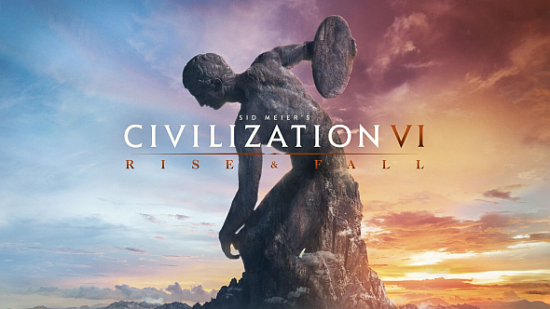Civilization VI Rise and Fall is the first major expansion pack for Firaxis’ current iteration of their long-running, exceptionally popular 4X series. If the base game wasn’t quite to your tastes, or if there was something you wished had a touch more detail, then Rise and Fall may just be the antidote you require: the huge expansion adds eight new civilizations, marks the return of Golden Ages, provides cities with Loyalty, introduces a new Emergencies mechanic, install Governors into cities, and a whole host of other new features.
New features and mechanics are the bedrock of Civilization Rise and Fall, but the expansion improves on the little things, too. There are new units, districts, and Wonders, all of which should help bolster your efforts in achieving total control of the globe.
Find your path to victory in our picks of the best strategy games on PC.
Our Civilization VI Rise and Fall ‘everything we know’ is a complete guide to everything the new expansion adds. If it’s new, it’s here. Think of it as a one-stop shop for everything you need to know, without the need to explore 70 different websites for all the little details.
Civ 6 Rise and Fall release date and review
Rise and Fall released on Steam on February 8, 2018. It costs $29.99, €29.99, or £24.99. We think it is pretty good; read all about it in our Civilization VI: Rise and Fall review.
Civ 6 Rise and Fall New Civs
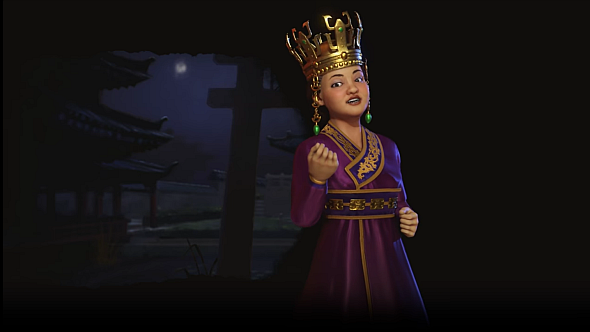
Naturally, Rise and Fall adds several new civilisations to the base game. Firaxis have addedeightnew civs with nine new leaders. Here’s who you can play as:
Korea return to Civ under Seondeok, queen of Silla – one of Korea’s three kingdoms – from the year 632 to 647. Their unique district, the Seowon, replaces the campus, must be built in hills, and yields a whopping +6 Science unless other districts are adjacent to it. Korea’s unique ability will add bonus science from mines, and Seondeok’s leader ability adds science and culture in all cities with a Governor. By beelining to Seowons and surrounding them with mines, Korea can open an early lead in the tech race. They sound pretty strong to us.
The Dutch are led by Queen Wilhelmena, who saw the country through two World Wars. Polders return as a unique improvement, and can be built on coastal tiles. Their unique unit is a warship with bonus range and combat strength against defensible city districts, while their ability grants bonus district yields for adjacent rivers. The Netherlands seem like a bit of a jack-of-all-trades with an affinity for water – distinctive, but without a clear focus.
The Monglians return with who other than Genghis Khan at the helm. Predictably, they’re a cavalry-focused warmongering civ, with Genghis granting combat strength to all cavalry and the ability to capture enemy cavalry, adding it to the horde. Their unique building grants a movement bonus to any cavalry trained in the local city, and the Keshig horse archer returns as their unique unit. Only their unique ability stays relevant after cavalry become obsolete: it grants combat strength to all units for each level of diplomatic visibility on a rival civ, and helps Mongolia achieve said visibility by putting a trading post in the target city of all outgoing trade routes.
New Indian leader – Chandragupta
India becomes the second civ with an alternate leader, as Rise and Fall adds Chandragupta. He’s far more martial than Gandhi: he allows you to declare a War of Territorial Expansion, granting your units additional movement and combat strength in the opening turns of the following war. A good time to make use of this would be alongside India’sVáru elephant.
The Cree were one of the largest Native American cultures in Canada. They get a stronger scout as their unique unit, a versatile tile improvement that can produce as many as four different yields depending on its adjacencies, and can claim land with traders. A modern Cree leader has voiced concern on this last point, saying that these mechanics do not reflect the Cree’s “traditional ways and world view.”
Georgia’s unique ability enables them to pick a second bonus when transitioning into a Golden Age, which is potentially huge (and very flexible) if you can chain them together. Otherwise, they’re all about faith and fighting: their leader, Tamar, can declare Protectorate Wars after getting the Theology civic, and she gets double faith for ten turns after doing so. Georgia’s unique structure is the Tsikhe, a cheap replacement for Renaissance Walls, which also provides faith. All these bonuses also dovetail neatly with the Khevsureti unique unit – a medieval warrior who gains combat strength in hilly terrain.
Provided you can keep them happy, the Scots are a potential powerhouse of science and production: happy cities get +5% of both yields, as well as +1 great scientist/engineer points for every campus/industrial zone. These bonuses are doubled if the city is ecstatic. You can use their unique improvement, the Golf Course, to help with this, as it provides amenities, appeal, gold, and culture. Their leader, Robert the Bruce, can declare Wars of Liberation with a much earlier civic than rival civs and gets bonuses to production and movement when doing so.
The Mapuche are a South American indigenous tribe who, under their leader Lautaro, resisted the Spanish Conquistadors in the 16th century. They play interestingly with two of Rise and Fall’s new systems: they get bonus combat strength versus enemies in a Golden Age, bonus combat XP for units trained in cities with a governor, and Lautaro reduces the loyalty of enemy cities for each unit defeated in his territory.
Shaka’s back to shake things up – the Zulu are once again a dangerous military civ, with the ability to form corps and armies instantly through city conquest or outright at their unique district, the Ikanda. Conquered cities are also more loyal, obviating one of the main hazards of warmongering in Rise and Fall. Shaka produces corps and armies faster and makes them stronger, while the unique unit – the Impi – is much cheaper than the pikemen they replace, and earn XP faster.
Civ 6 Rise and Fall Golden Ages
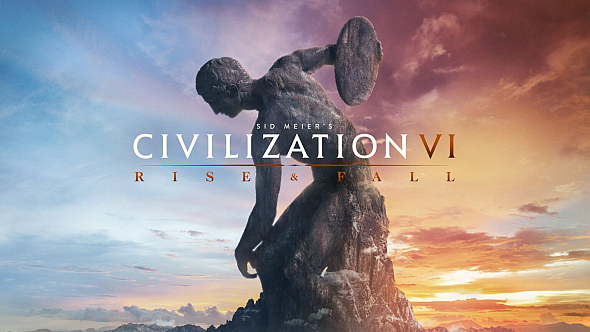
Golden Ages return in Rise and Fall, and they’re joined by Dark and Heroic Ages, too. Like in Civ V, there is now a global era as well as individual player eras. The next global era is triggered by any civ fulfilling its particular conditions, and when each era dawns, every civ’s performance in the previous era is evaluated. It’s this evaluation that determines whether you get a Golden Age… or not.
Your performance is measured by your Era Score – you need to hit a certain threshold to trigger a Golden Age, or fall beneath the requirement for a normal age to find yourself in a Dark Age. There are three sources of Era Score that we know of: your place in the tech and civics trees relative to the Era, Historic Moments, and your Age Dedication.
Historic Moments are like gamplay achievements – things like circumnavigating the globe, or founding a new religion. Your Dedication is a strategic choice for your civ’s direction that you will make in each era, and it’s either an objective or a buff depending on what kind of Age you’re in. A Religious Dedication in a Dark or normal age, for instance, will give Era Score for achieving religious goals, like converting a rival city to your faith. If you’ve already achieved a Golden Age, a Religious Dedication will buff your religious units. Successive Golden Ages will be harder to earn than your first, and they’ll be very hard indeed to chain together, because Dedications don’t contribute to your Era Score when they are in their ‘buff mode’.
As you might expect, being in a Dark Age has its downsides. Most significantly, all your cities’ Loyalty (see below) will take a hit, so you’ll have to work doubly hard to keep your empire intact. That said, some government policies are only available in a Dark Age, and they sound like powerful but risky choices to represent your civ knuckling down in hard times. “We’re not going to do as much with trade or diplomacy, but in turn, our internal production – our food, or whatever the case may be – is going to be stronger,” says producer Andrew Frederiksen.
If, while in a Dark Age, you earn enough Era Score to qualify for a Golden Age, you’ll instead receive a more powerful Heroic Age, in which you get to pick three dedications rather than just one. Indeed, Strenger says there are some devs who ‘zigzag’ between Dark and Heroic Ages as a strategic choice, rather than opting for the calmer course of normal and Golden Ages.
Civ 6 Rise and Fall Loyalty
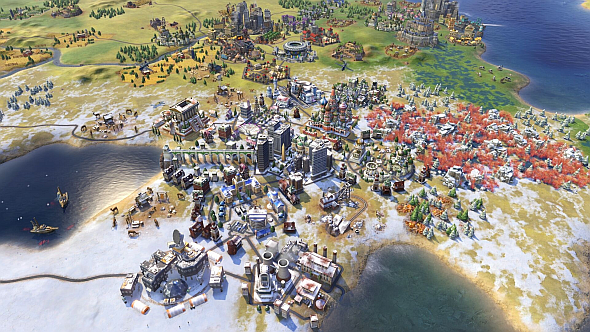
Cities now have individual Loyalty to your leadership, measured as a percentage. As Loyalty falls, so does productivity (in other words, lower yields). You’ll then see revolts, and ultimately, a city might declare its own independence, becoming a Free City. Free Cities have armies and will defend themselves, but don’t have quests or suzerains, like city states.
Instead, they can be absorbed by rival civs, either through military force or Loyalty. Loyalty is thus the equivalent of previous Civilization mechanics – such as Civ V’s ideological influence – that enabled you to take other cities without military intervention. It can’t be done directly now, though – every city has to become a Free City first. Interestingly, Frederiksen says you’ll be able to absorb city states with Loyalty, but you’ll lose their suzerain bonus, just as if you’d conquered them.
Loyalty emanates from cities in a similar manner as religious pressure, so it will be more of a problem in wide, sprawling empires than tight, tall ones. This makes forward settling other civs a more complicated choice, and has required some tuning for civs like England, who are nudged to settle far away, says Frederiksen. As we’ve seen, Dark and Golden Ages act like Loyalty bombs, tanking or buffing your cities’ Loyalty empire-wide respectively. Amenities affect Loyalty, too, but the most direct way to boost Loyalty is sending a Governor to your city (see below).
Civ 6 Rise and Fall Emergencies
Emergencies are a way to challenge leading players without acting like an artificial rubber banding mechanic. Emergencies represent threatening events on the world stage – a civilisation launching its first nuclear weapon, or converting the Holy City of a rival religion, for instance. There are many types, with different triggers.
When an Emergency occurs, the game determines which other civs are eligible to join a pact against the threatening civ. They may then choose whether or not to opt in, and there’s plenty to consider. Such pacts will have various time-limited goals according to the Emergency, and a buff to help you complete it – in the case of the nuke, you might get the task to capture the city that launched it, and combat bonuses against the offending civ.
Completing the objective in time will grant a boon for the rest of the game, but if you fail, the targeted player will get bonuses of their own for surviving the pact.
Civ 6 Rise and Fall Governors
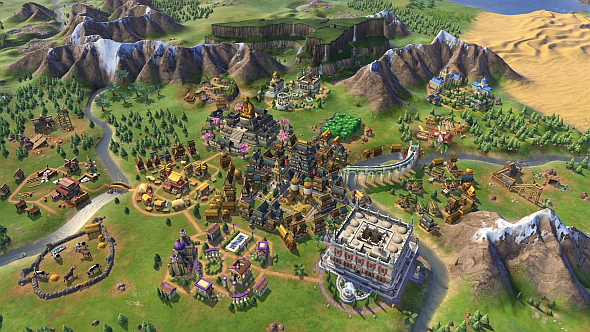
You’ll be familiar with this concept if you’ve ever played an Endless game – Civ VI is getting Governors. These are special characters who can be assigned to cities (they don’t exist on the world map) to give them powerful bonuses according to their unique promotion trees.
There are seven different types of Governor, inspired by historical archetypes, and you can only have one of each. You can spend a Governor Title to either recruit a new one, or promote an existing one, so there’s a nice wide/tall trade-off there. Governor Titles are primarily unlocked through the Civics tree, but there are other sources, such as wonders and city buildings.
- Liang, the Surveyor:Liang is all about construction and growth – especially amenities. She can grant 30% production when building any district (and again when building entertainment districts), and unlock special improvements – the City Park and the Fishery – that can’t be built any other way.
- Reyna, the Financier:money, money, money. Reyna can double adjacency bonuses from harbours and commercial hubs, add bonus gold from both citizens and foreign trade routes, and even enable you to purchase city districts with gold, like you can with buildings and units.
- Amani, the Diplomat: exerts Loyalty pressure on nearby rival cities each turn, increasing the chance they’ll declare indpendence and, if already independent, increasing the chance they’ll join your own civ. You can even put her in a city-state, where she’ll act as an envoy on top of these effects.
- Moksha, The Cardinal:Moksha is far more focused on religion than many of the other governors are on their presumed domains. His promotions buff religious combat, construction of Holy Sites, religious defences, and so on. An obvious must-pick for the religious victory.
- Victor, the Castellan: don’t mind his martial look:Victor is a defender, not a conqueror. His promotions buff your security against spies and attacking armies, granting extra ranged attacks, defensive and anti-air combat strength, and preventing cities from being put under siege.
- Magnus, the Steward: a master of industry and domestic affairs, Magnus’s promotions are some of the most useful for builder types. He overlaps with Liang in some confusing ways. Highlights include extra production from strategic resources, lifting the requirement for strategic resources to build dependent military units, and bonus growth and food for internal trade routes.
- Pingala, the Educator:you’d assume this is your guy for science, and he is, but there’s plenty else going on with his promotions. They enable faster construction of campuses and theatre squares, faster great people points, and more production for both nukes and space programme projects.
All Governors will also bolster a city’s Loyalty, so wide players will probably want to recruit many rather than promote a few, and send them around their empire keeping the people in line. Governors have five promotions each.
Civ 6 Rise and Fall Enhanced Alliances
Alliances now come in five flavours: Research, Military, Economic, Cultural, and Religious. Each will provide its own bonuses, which will strengthen the longer the alliance endures. Strenger tells us that the Research Alliance gives both allies Science bonuses to their trade routes at level one – a fairly modest bonus – but at level two, they will also get Tech Boosts at regular intervals. Level three includes all of the above, plus bonus Science when researching the same tech as your ally, or a tech already known to them.
Civ 6 Rise and Fall new units, wonders, districts, and more
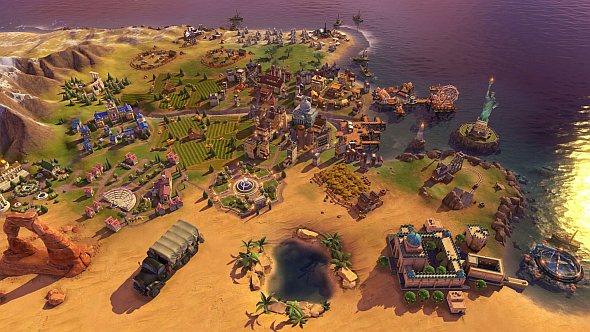
Alongside all these civs and systems, there is a trove of new content available to all players. This includes eight new world wonders, seven new natural wonders, four new units, two new tile improvements, two new districts, fourteen new buildings, and three new resources. There are also an unspecified number of new government policies (including Dark Age policies), new hidden leader agendas, and new Casus Belli.
We’ve seen a few early screenshots, and we’re going to make some guesses about a few of these items. We’re pretty confident about them – and you can see the evidence for yourself elsewhere in this article – but do note they haven’t been officially announced yet.
Civ 6 new Wonders:
There are eight new World Wonders due in Rise and Fall. Some have been revealed by Firaxis, but others are visible in those early screens – we’ll indicate where we’re guessing, but here’s our list:
- Amundsen-Scott Research Station– can be seen in the bottom-left of the snowy screenshot. Offers a huge boost to science and production in all cities, extra great scientist points per turn, and bonus yields to snow tiles. This is basically how you can seal – or steal – the science victory in the late-game.
- Kilwa Kisiwani – visible in the bottom-right of the desert screen and since officially revealed, this wonder, representing an island community off the coast of Tanzania, grants bonus envoys and boosts yields from any City State of which you are Suzerain.
- Casa deContratación – visible in the grassy screenshot. Grants governor promotions, great merchant points per turn, and production, faith, and gold to cities with a governor.
- St Basil’s Cathedral– good to see Firaxis haven’t confused it with the Kremlin this time around. Doubles religious tourism to its host city, as well as bonus food, production, and culture on tundra tiles. Also has slots for relics.
- Kotoku-in– can be seen to the top-left of the centre of the grassy screenshot. Grants +20% faith in its host city, and spawns four warrior monks – a new military unit with a unique (and powerful) promotion tree and the ability to spread religion whenever it defeats an enemy unit.
- Statue of Liberty– grants bonus settlers and Loyalty to nearby cities. Settlers seem a little redundant in the late-game, so let’s hope the Loyalty boost is significant.
- Taj Mahal– leaning into the Great Ages mechanic just as it did in Civ V, the Taj Mahal grants bonus Era Score for every Historic Moment earned for the rest of the game.
- Temple of Artemis– visible in the snowy screenshot. As in Civ V, it unlocks with Archery. This time it grants bonuses to food and housing, as well as amenities for nearby camps, pastures, and plantations. Alongside the Hanging Gardens, this is what you want to make a city pop in the early-game.
Civ 6 new units:
Four new, non-unique units will flesh out the tech tree:
- Pike and Shot – an anti-cavalry unit bridging the gap between Pikemen and Anti-Tanks.
- Supply Convoy – an upgrade to the Medic, which can increase the movement speed of units it shares a tile with, as well as heal them.It’s probably the truck in one of the new screens.
- Spec Ops – inspired by US Navy SEALs, these will top the upgrade tree that begins with the Scout, and will be able to para-drop forward without needing aircraft.
- Drone – an upgrade to the Observation Balloon.
Civ 6 new districts:
The new districts are the Water Parkand theGovernment Plaza. Water Parks are similar to entertainment districts in that they chiefly provide amenities, except they unlock later in the game, are more expensive, and can only be built on coastal tiles. They are more powerful when fully upgraded, however – their buildings also provide boosts to science and tourism, and their amenities extend over nine tiles rather than six. Useful for keeping yourself growing in the late-game, or for seafaring civs to bolster the loyalty of cities on foreign continents.
Only one Government Plaza can be built in your empire. It boosts loyalty and provides a governor title when built, after which you can choose one of three upgrade buildings in each of three escalating tiers. These buildings unlock alongisde government types of the corresponding tier, and are flavoured according to your strategy. At tier three, for instance, you can choose between the War Department, National History Museum, or Royal Society – these support conquest, culture, and science respectively. All Government buildings provide a governor title.
Civ 6 Rise and Fall Timeline
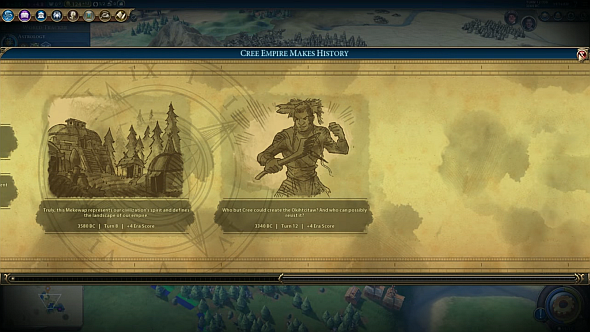
More of a nice flavour feature than anything else, Rise and Fall will chronicle your Historic Moments in a Timeline, which you’ll be able to open and review at any time. These moments include circumnavigating the globe, training your unique unit, founding a religion, and even building districts with high adjacency bonuses – finally, sound urban planning gets the recognition it deserves.
There are over 100 such moments planned, the most important of which will have their own unique illustrations on your timeline. We got our first look at this in the Cree reveal trailer (see image).
